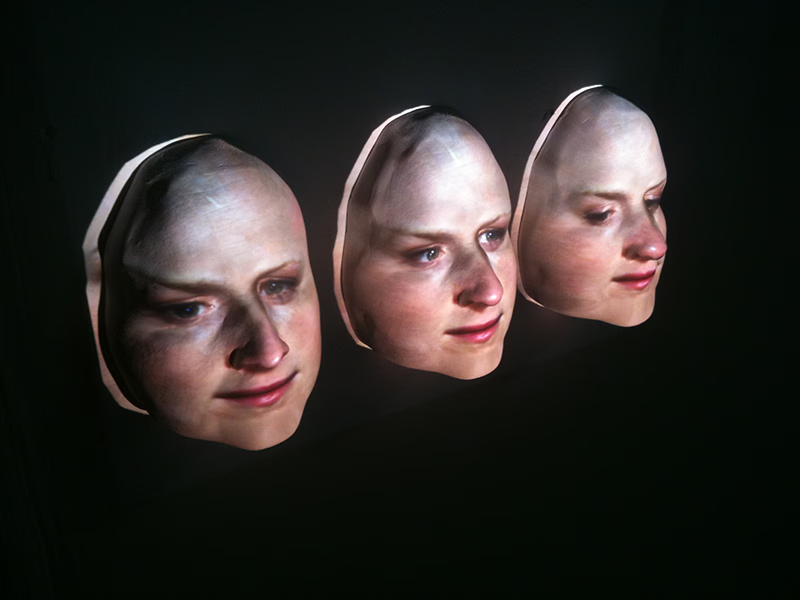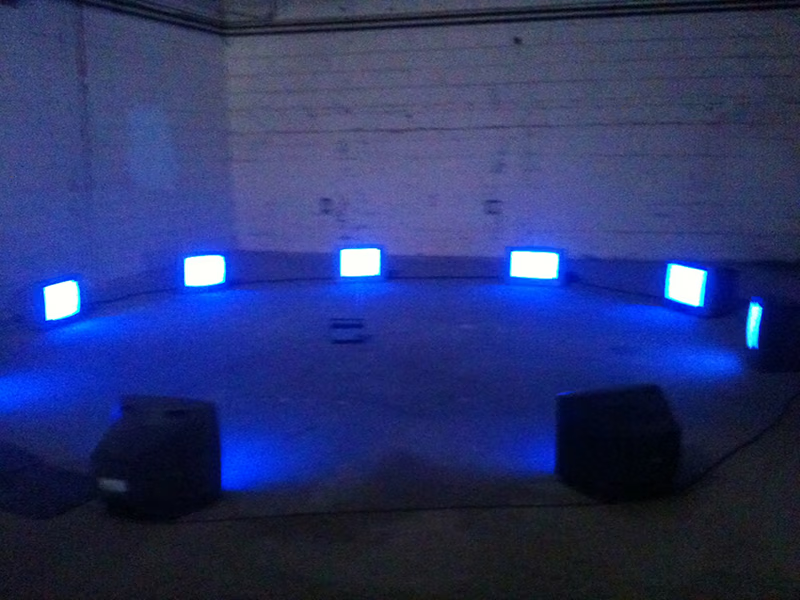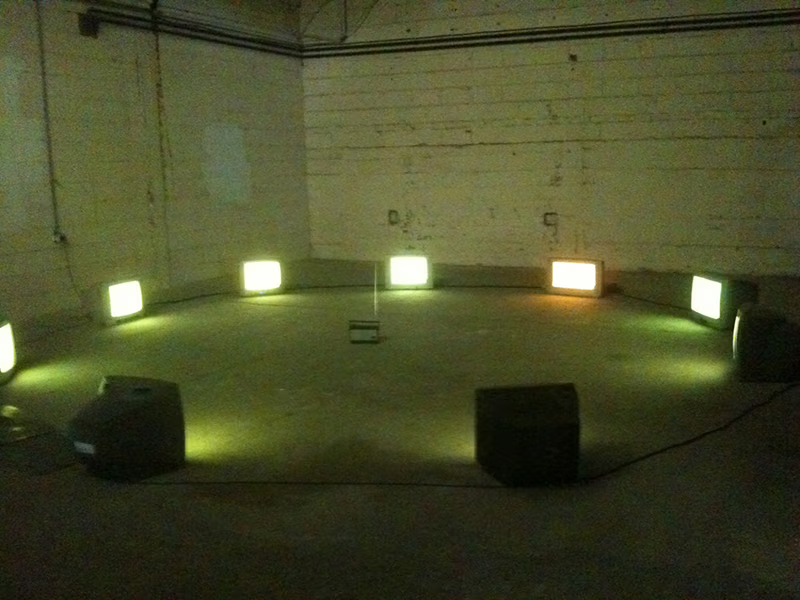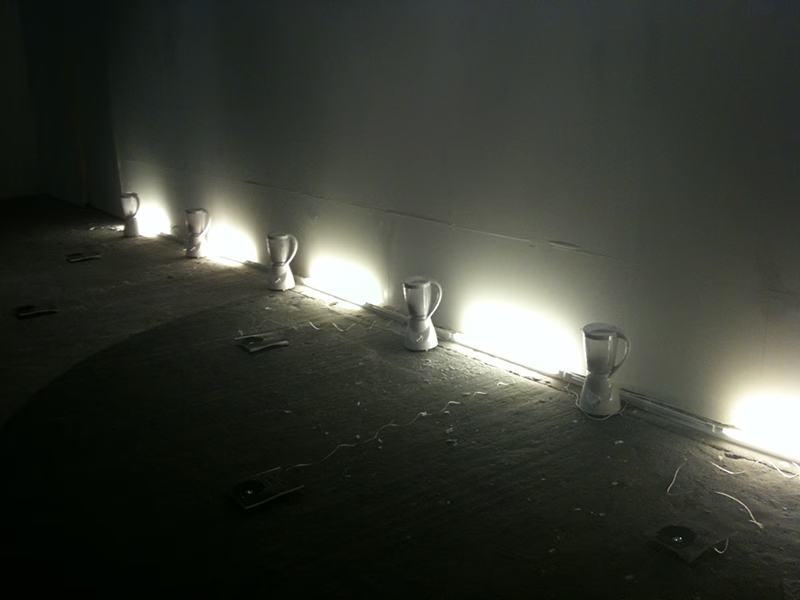
Adam Gibney’s first solo exhibition, ‘Limbo Excavated’ is currently on view at Plane/Site (IMOCA/Moxie).
On arrival I could hear a composite of sound works in the distance. I first stopped at a circular set of televisions that were laid out in a bright alcove, and ring-fenced by their own wiring. In the centre, a radio instructed the circle to display a cycle of bright primary colours. The televisions could not maintain synchrony with their rapid instructions, and the radio instructed them to stop – their mishaps ended in a temporary broadcast of fuzzy monochromatic static, before launching back into coloured life. Of the seven works in the exhibition, all included constant transmissions of recorded speech, and all employed their recordings as an instructional device for another machine.
The main warehouse area had its windows blacked out, and was lit by spotlights, projectors and fluorescent tubing. I entered the dark through a thin door, and was presented with a white four-door sedan, its tyres partly deflated, and its bodywork emitting a dim greenish hue. This green was provided by two overhead projectors, which quickly snapped into a pale red, and back to green. In a small indent between the door and its window I could see the outlines of cartoonishly large and distressed pixels. The car’s window was open and a woman’s voice played through a set of speakers, which had been propped on top of the headrests. She hurriedly suggested a palette of colours and the projectors obliged in kind, swapping their way through exterior after exterior, dignifying the whims of an indecisive recording. Gibney had loosely mapped the car’s frame into his projection; the front door flipped incongruously to a different colour than the rest of the car.
Occasionally, the conflicting sounds of recorded speech were interrupted by a mechanical roar. This interruption came from an installation entitled Truth Serum, a regiment of six domestic food blenders standing against the back wall of the warehouse.
The blenders were timed to begin spinning for a few seconds in every minute, and contained the indistinguishable remnants of something like cotton or paper. They sat on the ground beside a long arrangement of fluorescent lights, and seven flat brown speakers. As the blenders continued their work, the fluorescent tubes slowly alternated through a cycle of flashing patterns. Each speaker was captioned with the words “Tractatus logico-philosophicus – Ludwig Wittgenstein”; this refers to a book-length philosophical treatise, which outlined the relation between language and reality. At random, one of the speakers emitted a brief recording. I presumed that this robot female was recycling portions of Wittgenstein’s text.



In the next room I encountered a revision of the earlier television circle, entitled Class of 2011. In contrast to its sibling, this enactment rehearsed its colourful cycle in perfect synchrony. Again, a wireless radio sat in the centre of the room, announcing robotic instructions: “Blue. Green. Red. Blue. Red. Blue. Yellow.” The room had been blacked out entirely, and as the televisions ran through their sequence the walls were lit up. I walked into the centre, and my presence briefly disturbed the radio’s reception.
Along the sides of IMOCA’s warehouse, Gibney had cast a female face in five plaster casts, and affixed the series to opposing walls at just below shoulder height. Two feet from the wall a plinth disguised a projecter and speakers, which discharged the visage of a bald woman. These faces emitted halfway from the wall; each having been cut off before the ear. The projector and the face were engaged in another pre-recorded robotic discussion in which the projector calmly taught the buggy, indolent being about the finer points of English grammar and diction.

The faces were approximated on top of an static model. They blinked, spoke and made the gestures of breathing; their rough plaster surface immediately brought a death mask to mind. The uncanny deadness was stronger still coming from the only works in the exhibition that were not readymade.
The term ‘limbo’, being part of the exhibition’s title, took on a useful turn here: it is generated from the Latin term ‘limbus’, which refers to an anatomical border. To take this etymology further, in the human brain the limbic system controls our behaviours, emotions and long-term memories – facilities that these robotic faces lacked. They acted like a programmed intelligence – one that has barely come to life, and cannot surpass the need for basic motor skills.
The faces blankly rehearsed the English language as each projector conducted its back-and-forth: “React. React. Science. Science. Carrots. Carrots. Stereo. [Inaudible]. Reality. Beel–Beel–Beel–Beel–Beel–Beel–Ih–Cts–Reality. By the way, the dictionary usually will not show you this little added sound. That always surprises me, but they just don’t note it. I sure wish they did. Me too. Alright, that’s all for today everyone. Thanks for listening, bye-bye.”